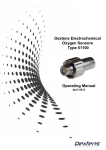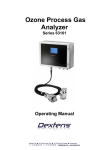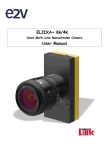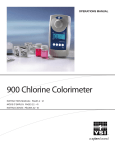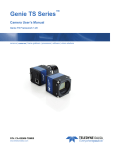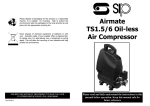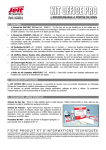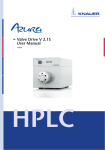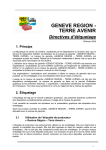Download Operating Manual Dextens Thermo Conductivity Sensors
Transcript
Dextens Thermo Conductivity Sensors Type 52101, 54101, 55101 Operating Manual May 2012 Table of Content 1 GENERAL INFORMATION.........................................................................................................................................4 1.1 1.2 1.3 1.4 2 INTRODUCTION .........................................................................................................................................................5 2.1 2.2 2.3 2.4 2.5 2.6 3 CONTENT OF PACKAGE: THERMO CONDUCTIVITY (TC) SENSOR ..............................................................................5 ACCESSORIES .......................................................................................................................................................5 STORAGE INFORMATION ........................................................................................................................................6 TECHNICAL SPECIFICATIONS ..................................................................................................................................6 SENSOR DIMENSIONS ............................................................................................................................................7 PRINCIPLE OF MEASUREMENT................................................................................................................................7 MAINTENANCE AND CALIBRATION .......................................................................................................................8 3.1 3.2 3.3 3.4 3.5 3.6 4 DISCLAIMER ..........................................................................................................................................................4 SYMBOLS AND CONVENTIONS ................................................................................................................................4 SERVICES AND REPAIRS ........................................................................................................................................4 CE CONFORMITY ..................................................................................................................................................4 INTRODUCTION ......................................................................................................................................................8 WHAT TO MAINTAIN ...............................................................................................................................................8 DISASSEMBLY .......................................................................................................................................................8 REPLACING THE MEMBRANE ................................................................................................................................10 REASSEMBLY ......................................................................................................................................................14 CALIBRATION ......................................................................................................................................................16 TROUBLE SHOOTING .............................................................................................................................................17 4.1 4.2 4.3 4.4 4.5 CALIBRATION OUTSIDE OF THE DEFINED RANGE ....................................................................................................17 PUNCTURED MEMBRANE .....................................................................................................................................17 EMPTY ELECTROLYTE RESERVOIR .......................................................................................................................17 DIRTY SENSOR ...................................................................................................................................................17 SLOW SENSOR....................................................................................................................................................17 Dextens SA 18 Chemin des Aulx 1218 Plan-les-Ouates Switzerland T + 41 22 884 83 06 F + 41 22 342 48 60 [email protected] www.dextens.ch 3 1 General Information 1.1 Disclaimer Please read and understand the user manual before installing and using the products described herein. It is also recommended to follow the safety recommendations from this manual. The material in this manual is for informational purposes only. The products it describes are subject to change without prior notice, due to the manufacturer’s continuous development program. Dextens makes no representations or warranties with respect to this manual and shall not be liable for any damages, losses, costs or expenses, direct, indirect or incidental, consequential or special, arising out of, or related to the use of this manual. All rights reserved. No part of this manual may be used or reproduced in any form or by any means without prior written permission of Dextens. 1.2 Symbols and Conventions The danger sign (below) indicates actions or configurations that may be dangerous for the user or that may lead to wrong measurements. Read and understand these paragraphs before starting to use the described material. 1.3 Services and Repairs No sensor components can be repaired by the user. Only personnel from Dextens or its approved representative(s) is (are) authorized to attempt repairs to the sensor and only components formally approved by the manufacturer should be used. Any attempt at repairing the sensor in contravention of these principles could cause damage to the sensor and corporal injury to the person carrying out the repair. It renders the warranty null and void and could compromise the correct working of the sensor and the electrical integrity or the CE compliance of the sensor. 1.4 CE Conformity The TC sensors instruments are manufactured conforming to the requirements of the electromagnetic compatibility directive 89/336/CEE and the low voltage directive 73/23/CEE. Dextens SA 18 Chemin des Aulx 1218 Plan-les-Ouates Switzerland T + 41 22 884 83 06 F + 41 22 342 48 60 [email protected] www.dextens.ch 4 2 Introduction 2.1 Content of Package: Thermo Conductivity (TC) Sensor When ordering a TC sensor, you will receive the following item: 52201: H2 sensor / 52401 CO2 sensor / 52501 N2 sensor Physical Description: 1.Purge Gas Outlet 2.Protection Cap 1 2 3 3.Purge Gas Inlet 4.Output Connection to instrument 5.Input Connection from in-line temperature sens 4 5 This user manual 2.2 Accessories Depending on your order, additional accessories can be delivered: Part Nr. 75502.mmm Cable for connecting the sensor to a process instrument Dextens SA 18 Chemin des Aulx 1218 Plan-les-Ouates Switzerland T + 41 22 884 83 06 F + 41 22 342 48 60 [email protected] www.dextens.ch 5 Part Nr. 87410 / 87411 Sensor maintenance kit 2.3 Storage Information During a long period of inactivity (more than 1 week) the sensor should be removed, wiped dry and stored properly. For shorter periods of inactivity (weekends) it is not necessary to remove the sensor: it may stay in place with the instrument turned on, and with purge gas supplied. Storage instructions: - rinse possible deposits on sensor’s head (rinse under tap water) - wipe sensor head dry - put a small silica desiccant bag inside the storage cap - put the storage cap in place - store the sensor in a safe dry place - temperature of storage place must be stable and correspond to common indoor levels Rapid temperature changes must be avoided (for instance air conditioning turned on and off daily) : they can create condensation inside the sensor’s cell and damage the electronics inside. 2.4 Technical Specifications Sensor Model CO2 H2 Sensor serial number 52401 52201 52201 52501 Membrane model number 90956 90956 90952 90956 Measurement range at 25°C 0-15 g/kg 0-2 ppm 0-10 ppm 0-350 ppm Linear flow rate 50 cm/sec N/A N/A 150 cm/sec Accuracy 1% of the measured value or lowest value whichever is greater Temperature compensation 0°C to + 50°C / 32°F to 113°F Temperature range CIP or SIP resistant up to 120°C / 248°F Pressure range 0 – 20 bars Cycle time 20 sec Recommended purge gas N2 or air Weight 0.6 kg Enclosure protection IP65 Material in contact with sample Sensor cable N2 or air N2 N2 or air CO2 or air ANSI 316L, PFA or Tefzel 3m standard length / optional extension up to 1000 m Dextens SA 18 Chemin des Aulx 1218 Plan-les-Ouates Switzerland T + 41 22 884 83 06 F + 41 22 342 48 60 [email protected] www.dextens.ch 6 Introduction 2.5 Sensor Dimensions Length: 159 mm Max Diameter: 59 mm Min Diameter: 27.95 mm D 59 mm 159 mm M42x1.5 D 27.95 mm 2.6 Principle of Measurement This thermal conductivity sensor is designed to continuously measure Carbon dioxide (CO2), Nitrogen (N2) or Hydrogen (H2). Measurements are possible in dissolved or gaseous applications. The sensor operates on the following principle: the gas to measure diffuses from the sample into a micro volume contained in the sensor through a semi-permeable membrane, and comes into contact with a gas thermal conductivity detector. The temperature and the change in thermal conductivity induced by the presence of the gas is measured. The duration of a single measurement is too short to get a reliable measure: successive measurements are made, which induce each time a conductivity curve. The average slope of each measurement curve determines the average conductivity, which gives the gas concentration of the sample. To perform the successive measurements, it is necessary to purge the gas enclosed in the micro-volume (every 10 seconds). This purge is done by injecting a purge gas, which is different from the sample to be measured (for instance N2 for a CO2 measurement). A purge valve controlled by an electronic card drives this process. After each purge, the gas to be measured diffuses again through the membrane into the sensor and a new measurement is performed. Dextens SA 18 Chemin des Aulx 1218 Plan-les-Ouates Switzerland T + 41 22 884 83 06 F + 41 22 342 48 60 [email protected] www.dextens.ch 7 3 Maintenance and Calibration 3.1 Introduction This guide explains how to clean and carry out basic maintenance of Dextens thermo-conductivity (TC) sensor models: • There is no definitive rule to when you clean a sensor. • Nor is there is a “standard” service interval. However, you should clean a sensor when: • It is slow • It is noisy • The calibration is out of range • It is visibly dirty Dextens offers a maintenance kit and cleaning unit which provides all the components necessary to complete the cleaning and basic maintenance of a sensor. Periodically, check the sensor calibration using a known standard. As long as the reading is ±1 % of the expected value no action needs to be taken. If the calibration has changed ±1–10 %, perform a new calibration. If the deviation is more than 10% of the original values, a membrane service will be required. Only change the sensor membrane when troubleshooting indicates that the membrane has failed. A visual inspection of the sensor face will also reveal any problem like dust deposits or accumulation of dirt onto the protection grill. Please carry out the following operations in a clean dry place in order to avoid the possibility of blocking or damaging the stainless steel grill in the sensor’s face, or of allowing water to get into the sensor. Very Important Note: Unlike your O2 sensor, please remember that the TC sensors do not require regular servicing. While the membrane replacement procedure on these sensors is similar to that of the electrochemical sensor, no chemical or electrochemical cleaning is required, and furthermore, membrane changes need be performed far less often, if at all. 3.2 What to maintain There are just two components which should require maintenance on a TC sensor: • The Dacron gauze filter • The membrane We recommend that whenever the membrane is changed, the Dacron gauze filter is also changed. 3.3 Disassembly Remove the sensor from its flow chamber: Before removing the sensor from a sensor socket, make sure to first drain all liquid from the pipe. (If you are using a model 74001.00, 28mmTuchenhagen insertion/extraction valve, the sample is sealed off automatically as the sensor is withdrawn.) Holding the sensor handle in one hand, carefully unscrew the collar and pull the sensor out of the mounting (sensor socket, flow chamber, or other mounting, see section 2.2). You can “stop” the opening by replacing the sensor with the stainless steel plug and collar supplied for this purpose. Dextens SA 18 Chemin des Aulx 1218 Plan-les-Ouates Switzerland T + 41 22 884 83 06 F + 41 22 342 48 60 [email protected] www.dextens.ch 8 Maintenance and Calibration After removing the sensor from the line, unscrew the protection cap. Lift off the cap, taking care not to lose the grill and washers inside. Note: never remove the protection cap unless the membrane has failed. Dry the sensor thoroughly with a paper towel. The protective cap has a number of components which should come out with the cap when it is removed. To remove the Dacron gauze, simply gently push the contents of the protective cap apart. Dextens SA 18 Chemin des Aulx 1218 Plan-les-Ouates Switzerland T + 41 22 884 83 06 F + 41 22 342 48 60 [email protected] www.dextens.ch 9 Maintenance and Calibration Note the different components and washers. With the exception of the Dacron gauze, these can usually be re-used. 1. Protective cap 2. Tefzel washers 3. Grill (0.2 mm) 4. Dacron Gauze 5. Silicone washers 1 2 3 4 5 3.4 Replacing the Membrane Remove the membrane tightening ring with the tool. Place the larger section of the tool over the ring and pull to tool until it is tight around the rings middle section. Now just lift the removal tool and the membrane and tightening ring will come free. Take care that the protective pastille remains in place (it can fall out). If it does fall out, simply replace it with great care – DO NOT TOUCH the chip. It is extremely delicate and easily damaged. Remove the old membrane to reveal the stainless steel grill in the sensing face. The grill must be clean and dry. If necessary, wipe it with a paper tissue. Be careful not to drop the membrane support disk. If the mesh covering this support disk is damaged, replace the support disk with a new one. If the support disk is removed, the delicate sensing element is exposed. Do not touch it, even with a tissue —bonding wires would be irreversibly damaged. Dextens SA 18 Chemin des Aulx 1218 Plan-les-Ouates Switzerland T + 41 22 884 83 06 F + 41 22 342 48 60 [email protected] www.dextens.ch 10 Maintenance and Calibration You are now ready to replace the membrane: Stand the sensor on a flat bench surface so that it rests on its back end, with its working end facing up. Take the membrane installation tool from the maintenance kit and separate it into its two parts. Attach the tightening ring to the inner part as shown in the image on the right. Dextens SA 18 Chemin des Aulx 1218 Plan-les-Ouates Switzerland T + 41 22 884 83 06 F + 41 22 342 48 60 [email protected] www.dextens.ch 11 Maintenance and Calibration Place the lower part of the tool onto the sensor head as shown. Select a membrane from the maintenance kit. Take care – do NOT touch the middle surface of the membrane. Using a set of tweesers, place the membrane in the installation tool as shown. Dextens SA 18 Chemin des Aulx 1218 Plan-les-Ouates Switzerland T + 41 22 884 83 06 F + 41 22 342 48 60 [email protected] www.dextens.ch 12 Maintenance and Calibration The membrane should be evenly spaced, centrally within the support. Attaching the membrane: Place the upper section, with the tightening ring, over the lower part of the tool and press down slowly with an even but firm pressure. You will feel and hear the tightening ring click into place. Dextens SA 18 Chemin des Aulx 1218 Plan-les-Ouates Switzerland T + 41 22 884 83 06 F + 41 22 342 48 60 [email protected] www.dextens.ch 13 Maintenance and Calibration The attached membrane will look as follows: 3.5 Reassembly Replacing washers, dacron and grill. It is important to place the various protective cap components in the correct order. 1.Place 2 tefzel washers in the cap 2. Place the grill Dextens SA 18 Chemin des Aulx 1218 Plan-les-Ouates Switzerland T + 41 22 884 83 06 F + 41 22 342 48 60 [email protected] www.dextens.ch 14 Maintenance and Calibration 3. Place the dacron gauze pastille 4. Place the silicone washer Replacing the protective cap: Finally, replace the protective cap by screwing it back onto the sensor head. Take care that the components within the cap remain in place. Dextens SA 18 Chemin des Aulx 1218 Plan-les-Ouates Switzerland T + 41 22 884 83 06 F + 41 22 342 48 60 [email protected] www.dextens.ch 15 Maintenance and Calibration 3.6 Calibration The Dextens sensors are sold pre-calibrated and there should be no need to calibrate them between service intervals. For calibration process please refer to the operating manual of Dextens TC instruments. Dextens SA 18 Chemin des Aulx 1218 Plan-les-Ouates Switzerland T + 41 22 884 83 06 F + 41 22 342 48 60 [email protected] www.dextens.ch 16 4 Trouble shooting Even if Dexens sensors have been designed to reduce the sources of trouble, some harsh working condition may lead to sensor malfunction. This chapter is here to give some tips to find and correct the problem. 4.1 Calibration outside of the defined range • Calibration below 80% - it is possible that the reservoir is overfilled. Open and close the reservoir to reduce pressure and re-measure efficiency. • Calibration above 120% - membrane is probably too tight. Place in warm water overnight and re-measure efficiency. 4.2 Punctured Membrane A common problem with our sensor is that the membrane is fragile and can be easily punctured or torn (when not protected by the protective grill). The symptoms of this problem are reading that are not going down or very slowly. The only response to this is to thoroughly clean the sensor and replace the membrane. When the membrane has been broken the sampling liquid enters the reservoir. To get a fully working sensor you will remove all traces of the liquid. 4.3 Empty Electrolyte Reservoir Another frequent problem is that the electrolyte leaks out of the reservoir. This happens after bad maintenance when the operator has not completely closed the reservoir. But the effect of this problem can sometimes be detected after a quite long time because of a small leak. The symptoms of this problem are a sensor that is not measuring anything and which becomes very sensitive to pressure changes. To correct the problem, do a complete maintenance taking much care to completely close the electrolyte reservoir. 4.4 Dirty Sensor After some time, in normal use, the sensors becomes dirty. They are much slower to go down and the response signal is quite noisy. The only thing to do is a maintenance, some times with a chemical clean (see §4.4.4). 4.5 Slow Sensor If, when completing the sodium sulfite test, the sensor does not reach 10 ppb in 10 minutes AND 0.4 ppb in 60 minutes then let the sensor sit for 1 hour connected to the instrument. This will allow the sensor to consume any oxygen which may reside in the electrolyte. • Inspect the sensor for air bubbles. If there are none, then, retest the sensor speed. If there are bubbles you must rework the reservoir to remove them – either by topping-up the reservoir or completely refilling it. (Note – if you completely refill the reservoir you should recalibrate the sensor). • If the sensor is still not delivering to specification (bullet point 1 above) allow it to sit overnight connected to the instrument and retest. • If after testing and allowing the sensor to sit either for an hour or overnight performance is still not to specification check the following: • Is the membrane clean? • Are there no bubbles in the reservoir? • Inspect the cathode, guard and anode – are they clean? Even if they appear clean, re-clean the sensor (we recommend both aggressive and basic cleaning) and recalibrate and retest. • If after cleaning, re-cleaning and retesting the sensor is still not performing well, we recommend you contact Dextens Dextens SA 18 Chemin des Aulx 1218 Plan-les-Ouates Switzerland T + 41 22 884 83 06 F + 41 22 342 48 60 [email protected] www.dextens.ch 17
















